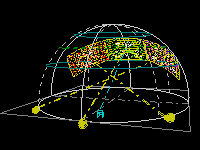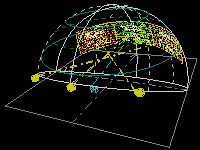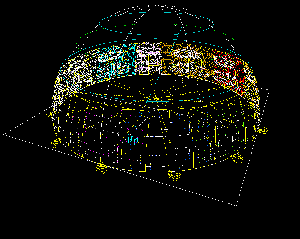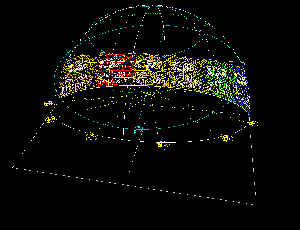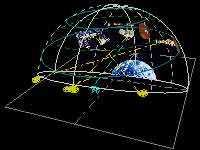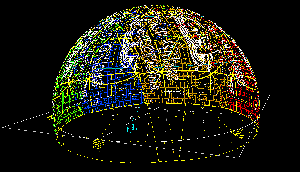| In the production studio: Computer with DVD/CD-ROM drive Image processing software Output device |
| In the theater: 1. Slide projectors in L-C-R array, at least 1 pair dissolvers |
| 2. Horizon panorama projectors |
| 3. All-sky projector system |
| 4. CRT Video Projector |
| 5. A capable planetarium projector and phasing Moon |
| 6. The ability to point out objects on cue |
| Recommended: 7. Zoom-slew |
Sky Quest Equipment Requirements
The Albert Einstein Planetarium in the Smithsonian Institution's National Air and Space Museum commissioned this show for their very modern theater, and naturally they want the program to look as good in other theaters as it does in theirs. But not every planetarium has the same wealth of equipment and capabilities. To determine if your planetarium theater can present Sky Quest, please read on to see what's required.
The show soundtrack and video clips are recorded on DVD, so you'll need a DVD player to play the disc, even if it's just to copy the audio and video to another medium, such as multi-track tape, video tape or server.
The show's still images are recorded on data CD, so you'll also need the resources (computer, image processing software, output devices) to transform the digital images into whatever form your theater uses to project. For most planetaria with slide projectors, that will mean making 35mm slides.
1. Slide projectors in L-C-R array, at least 1 pair dissolvers
This is a screen format familiar to long-time Loch Ness Productions customers.
Many of the scenes in our shows are illustrated with three images, which are introduced in sequential order: Left, then Center, then Right. After all three are up, they often "wipe" off or reveal the next set of three in the same order.
The Mars scene requires a critically-aligned lap-dissolve pair.
Beyond this array, you may wish to position auxiliary or "single-shot" projectors so that constellation and star names appear in the sky near the objects they're labeling, for example.
2. Horizon panorama projectors
In the digital age, what may be a 3-panel pan in one theater may be a 2- or 4-panel pan in another, or a pan can be remapped to an all-sky. Nonetheless, you'll need that calibrated set of projectors which project on the horizon, commonly known as a panorama system.
The show package contains three night-time panoramas of scenes introduced in the video. The observatory pan is in a 36:2 format ratio — it wraps around a full 360 degrees, but we also provide a split into two 180s for those without surround capability. The other two pans are 18:2 ratio, or what might otherwise be called 6-panel partial pans. These panoramas are intended to span 180 degrees on the horizon.
All this is in addition to the dissolvers, which project up in the sky, of course. There are times you'll use both together, such as when the Earth chord is on the horizon, and the Hubble Space Telescope over it.
3. All-sky projector system
There are two full-dome all-sky scenes. One depicts an urban light-pollution scene in a crowded shopping center parking lot, with tall light poles arching overhead. The other is the ending of the show, a "typical" suburban housing development back yard.

The show begins with a 5-minute video. In it, the main character introduces herself, takes us on a tour of her observatory, and relates a childhood experience of taking a trip to Mars via a cardboard rocket.
|
She wears red glasses to simulate the Martian environment, and we view the scene through her eyes. In the observatory, she switches off the work lights and sets up her night's viewing under low-light red illumination. |
As you probably are aware, red is a difficult color for the video medium in general, NTSC in particular. These red scenes can turn to an unviewable mush on conventional videotape; it's essential they run from a disc source.
The red scenes will be a challenge for even a good CRT-type video projector, as will the shots where a campfire illuminates the star-gazing characters.
|
|
In one scene, the figures are against black, so they can be positioned within a panorama. This necessitates the ability to position a video projector, beyond having it front-and-center. |
Another has a glowing star shrinking to a pinpoint to merge with the planetarium starfield. LCD video projectors do not project with a black, non-visible background, and thus aren't up to the task.
5. A capable planetarium projector and phasing Moon
Sky Quest really runs a planetarium projector through its paces, so it needs to be functioning fully. We roll from a spring/summer sky (Big Dipper prominent) to a winter sky (Orion front and center) — in 40 seconds. We point out Mars, and require annual motion to move it among the stars. We also point out Jupiter and Saturn.
What's more, we run the planetarium Moon through a month of phases in 40 seconds, starting with a waxing crescent, progressing through full halfway through, then to waning crescent. It takes accurate control of diurnal (and maybe polar) motion speeds to keep the Moon above the horizon for the entire cycle. Without automation, it's not an easy task.
The planetarium should be up to the challenge of depicting the red, yellow and blue star colors we talk about. Sirius in particular is of prime importance, since it's what starts our character on her sky quest — "it sparkled like a diamond, blue and white," she says. The Albert Einstein Planetarium used a special-effects projector to give Sirius colorful scintillation.
6. The ability to point out objects on cue
With this show, it's absolutely essential for various objects in the sky to be pointed out in time with the narration. There are more than 30 pointer cues to hit. With a handheld pointer, this will take hours of practice. It's unlikely that the "occasional" or untrained show presenter can effectively hit cue points on time just by reading along in the script. For example, we feature the familiar "Arc to Arcturus, Spike to Spica, Leap to Leo" mnemonic several times. Unless the pointer is exactly in position at the right time — not early, not late — it's just plain unacceptably wrong. At the Albert Einstein Planetarium, we automated all the pointer cues and actually drew lines between the stars, projected by over 15 individually positioned single-shot projectors. We also used their programmable zoom-slew for pointing to stars and planets.
Objects pointed out in the sky include:
- Big Dipper (seven individual stars, bowl, arc of handle)
- Arcturus
- Spica
- Leo (backward question mark)
- Cygnus
- Scorpius
- Orion (belt stars)
- Sirius
- Yellow star (Procyon)
- Red star (Betelgeuse)
- Mars
- Jupiter
- Saturn
Recommended: 7. Zoom-slew
While non-moving slides can illustrate the scenes, the show will benefit from having Voyager fly by Jupiter, Hubble drift slowly in Earth orbit, the spaceship fly toward Mars, the string of Comet Shoemaker-Levy 9 aim for Jupiter, etc. Capable zoom-slews could also perform some of the pointer functions.



